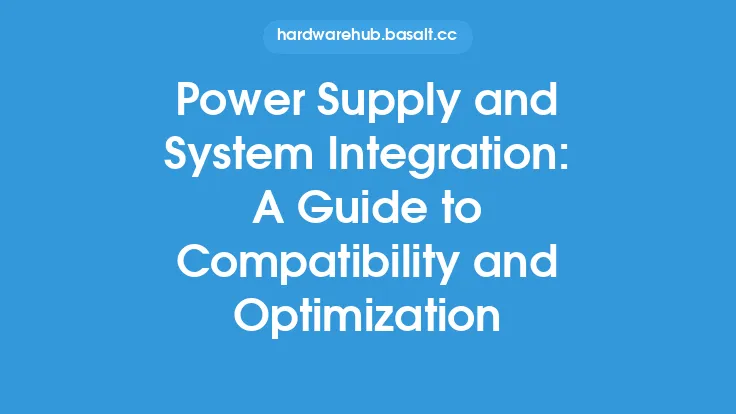When it comes to building or upgrading a computer, one of the most critical components is the power supply. The power supply is responsible for providing power to all the components in the system, including the CPU, motherboard, RAM, and peripherals. However, the power supply itself needs to be connected to these components using specialized cables and adapters, known as power supply connector cables and adapters. In this article, we will delve into the world of power supply connector cables and adapters, exploring their types, functions, and applications.
Introduction to Power Supply Connector Cables
Power supply connector cables are used to connect the power supply to the various components in the system. These cables are designed to carry electrical power from the power supply to the components, and they come in a variety of shapes, sizes, and types. The most common types of power supply connector cables include SATA power cables, Molex power cables, PCIe power cables, and ATX power cables. Each type of cable is designed to connect to a specific type of component, such as hard drives, graphics cards, and motherboards.
Types of Power Supply Connector Adapters
Power supply connector adapters are used to convert one type of power supply connector to another. These adapters are useful when the power supply does not have the correct type of connector for a particular component. For example, a SATA to Molex adapter can be used to connect a SATA hard drive to a power supply that only has Molex connectors. Other common types of power supply connector adapters include Molex to PCIe adapters, PCIe to SATA adapters, and ATX to EPS adapters. These adapters can be used to connect a variety of components, including graphics cards, hard drives, and motherboards.
Power Supply Connector Cable Length and Gauge
When it comes to power supply connector cables, the length and gauge of the cable are critical factors to consider. The length of the cable will depend on the specific application and the distance between the power supply and the component. For example, a longer cable may be needed to connect a power supply to a graphics card that is located at the other end of the case. The gauge of the cable, on the other hand, refers to the thickness of the wire. A lower gauge wire is thicker and can carry more current, while a higher gauge wire is thinner and can carry less current. In general, it is recommended to use a cable with a lower gauge wire to minimize voltage drop and ensure reliable power delivery.
Power Supply Connector Cable Management
Power supply connector cable management is an important aspect of building and maintaining a computer system. Proper cable management can help to improve airflow, reduce noise, and increase the overall reliability of the system. There are several techniques that can be used to manage power supply connector cables, including cable ties, cable clips, and cable sleeves. Cable ties can be used to secure cables to the case or to other components, while cable clips can be used to route cables through tight spaces. Cable sleeves can be used to protect cables from damage and to improve their appearance.
Power Supply Connector Safety Considerations
When working with power supply connector cables and adapters, it is essential to take safety precautions to avoid injury or damage to the system. One of the most critical safety considerations is to ensure that the power supply is turned off before connecting or disconnecting any cables. This can help to prevent electrical shock and to minimize the risk of damage to the components. Additionally, it is recommended to use cables and adapters that are rated for the correct voltage and current, and to avoid overloading the power supply. Overloading the power supply can cause it to overheat, which can lead to a range of problems, including component failure and system crashes.
Power Supply Connector Cable and Adapter Compatibility
When selecting power supply connector cables and adapters, it is essential to ensure that they are compatible with the power supply and the components. Incompatible cables and adapters can cause a range of problems, including voltage drop, overheating, and component failure. To ensure compatibility, it is recommended to check the specifications of the power supply and the components, and to select cables and adapters that meet those specifications. Additionally, it is recommended to use cables and adapters from reputable manufacturers, as they are more likely to be compatible and reliable.
Power Supply Connector Cable and Adapter Quality
The quality of power supply connector cables and adapters can have a significant impact on the reliability and performance of the system. High-quality cables and adapters can help to minimize voltage drop, reduce noise, and improve the overall efficiency of the system. On the other hand, low-quality cables and adapters can cause a range of problems, including overheating, component failure, and system crashes. To ensure that the cables and adapters are of high quality, it is recommended to select products from reputable manufacturers, and to check the specifications and reviews of the products before making a purchase.
Conclusion
In conclusion, power supply connector cables and adapters play a critical role in connecting the power supply to the various components in a computer system. By understanding the different types of power supply connector cables and adapters, as well as their functions and applications, users can ensure that their system is properly configured and running efficiently. Additionally, by taking safety precautions, ensuring compatibility, and selecting high-quality cables and adapters, users can help to minimize the risk of problems and ensure reliable power delivery to their components. Whether you are building a new system or upgrading an existing one, understanding power supply connector cables and adapters is essential for ensuring optimal performance and reliability.





